Lockwood
Custom Optics at the 2013
Okie-Tex
Star Party
|
I am finally writing this article in March of 2014, some five months after the actual event took place. So, I don't really recall the specifics of each night at the star party, with the exception of one that featured a somewhat rare event, but I do recall one thing - clear skies. I mean very clear skies. Almost no clouds, the kind of weather that spoils you for most other observing sites and star parties - the kind where you sleep in as late as possible in order to try to keep your energy up the next night, and where you sometimes wish for clouds to allow you to sleep without feeling guilty for not observing. Ideally, I would sleep until almost lunch, then go eat that for my breakfast. In fact, I think I've only had one or two actual breakfasts at Okie-Tex in the last couple star parties that I have attended, usually on the mornings that we start the two-day drive back to Illinois. So, the routine was - observe from dusk until around two or three am, go to bed, get up around 11 am, wash up, and have coffee, then lunch. We arrived on Saturday, Sept. 28th and settled into the usual star party routine. A few days into the star party, I found a familiar scope - a 30" f/3.7 Starmaster with my optics. I can't remember the owner's name, but we did some observing and I shared a few tips about using the scope. 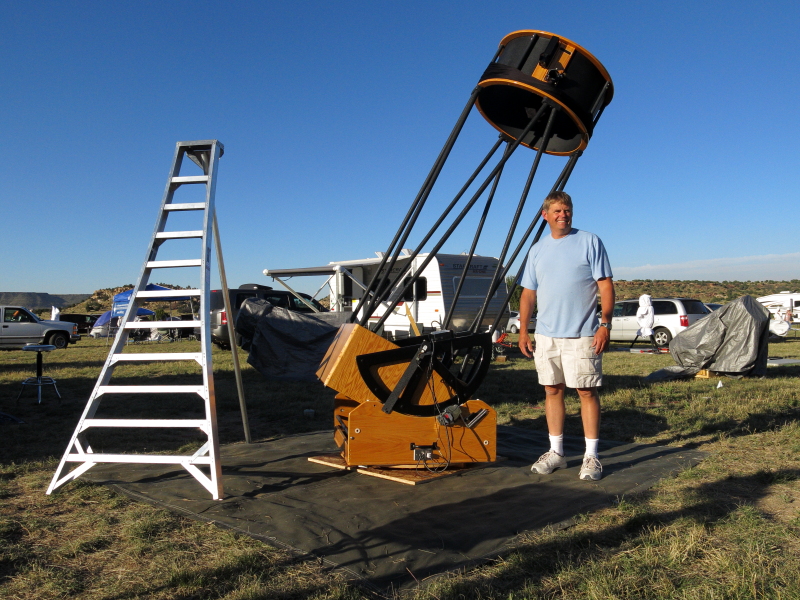 A line of clouds can just be seen barely creeping over the horizon on the right side of the photo - small remnants of cloud banks like this were about all we saw during the week. Later in the week I found the owner and scope gone before I could make it back over there for a second night of observing. Here are some images that I hope express and communicate the Okie-Tex sky on a typical night. 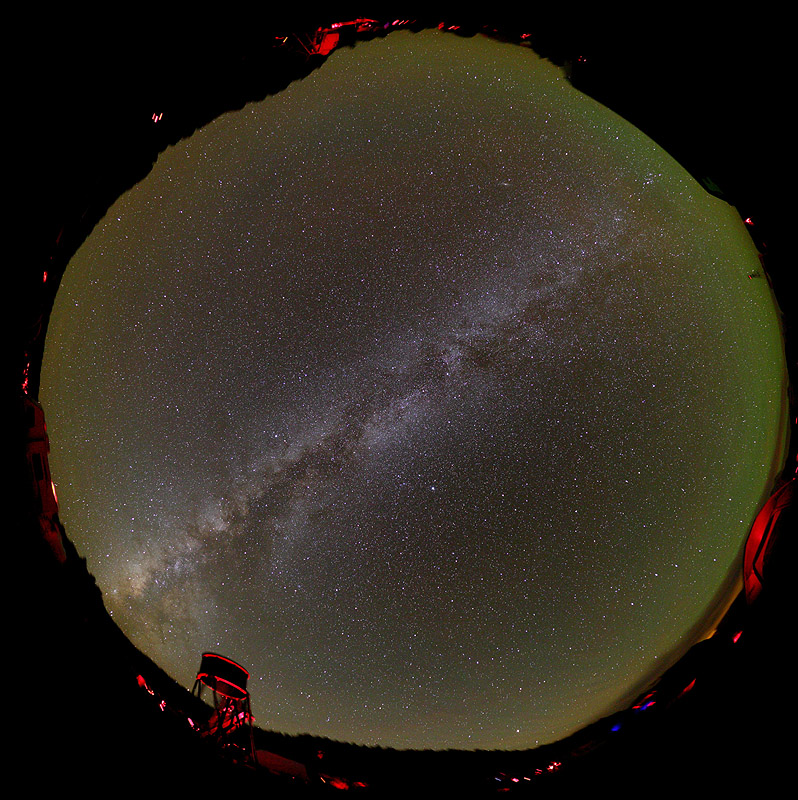 Above is an all-sky image, shot with an 8mm fisheye lens. For these, I had my DSLR mounted on my Equatorial Platforms aluminum tracking platform, typically shooting for ~3-4 minutes at F/4 with the fisheye and moderate ISOs. The above image shows the majesty of the sky, with a bright Milky Way arcing overhead, and continuing right down to the ridge line to the south (bottom left of the image, or ~8:00), where it was sharply cut off by rocks and scrub trees. At bottom right, some clouds hover on the northwestern horizon, and green skyglow is prominent, as is a tent illuminated by my red flashlight. An observer perched on a ladder views through a 32" telescope at lower left. 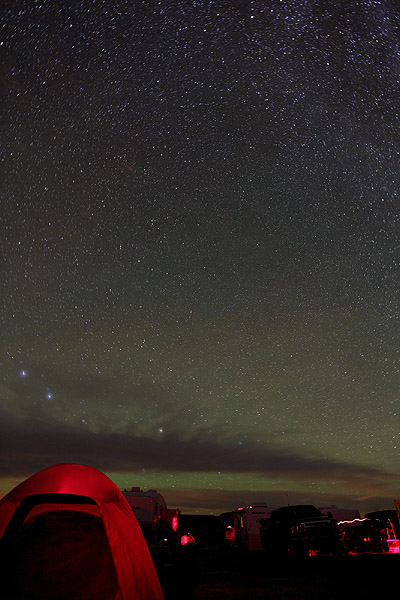 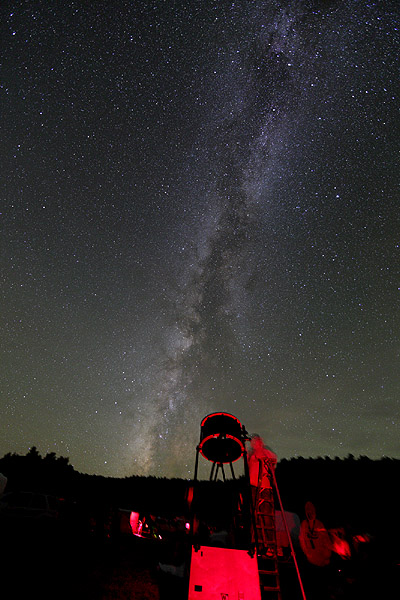 The images above show basically opposite directions. The image at left shows the northern sky, tents and RVs, with green skyglow highlighting dark clouds. Remember, in dark locations clouds are dark patches on the brighter sky, rather than brighter, lit-from-the-bottom clouds of vapor. Polaris is seen just above and left of the middle of the image, and the high clouds cause the stars of the big dipper to broaden and glow just over the tent. Above at right, an observer enjoys a view through Joe's 32" telescope with the Milky Way overhead. I know I have shot many images like this, but I just can't help to capture a few every year. 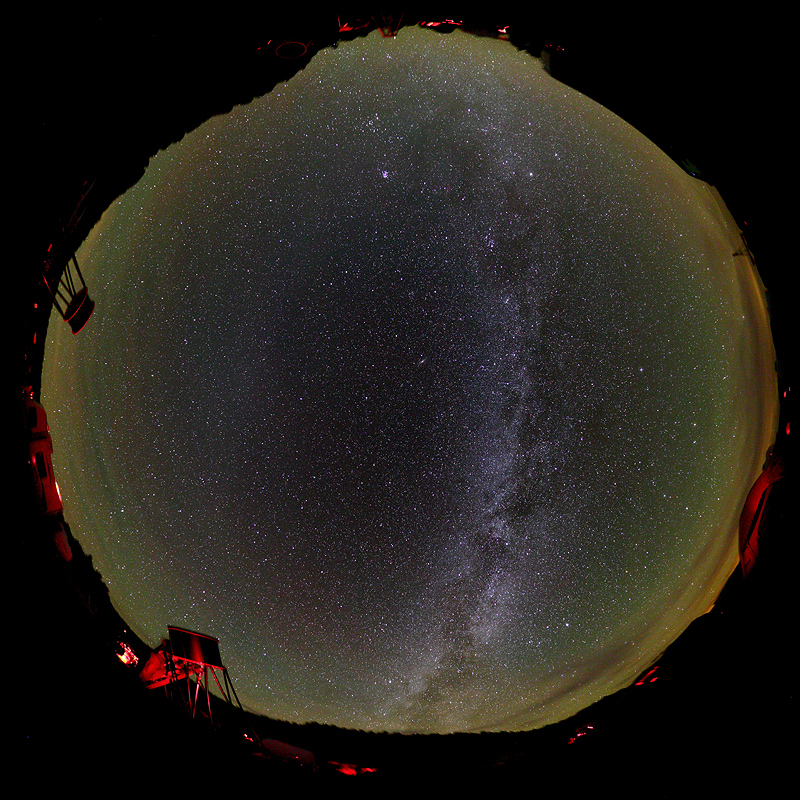 Some nights are not quite as transparent as others, like on the night that the above image was captured, when more hints of clouds, dust, and skyglow are present. Structure is apparent in the skyglow all around the horizon in the image above, especially at left, reminding us that it is a complicated, ever changing pheonomena with a life and personality of its own. Phenomena such as skyglow are visible from truly dark sites, such as this one, and sadly few people experience this. Also faintly visible in the above shot is the gegenschein and zodiacal band of dust. The skyglow, dust and possibly some very thin cloud make it less noticeable. However, on the next night it was much more easily seen and photographed, as seen below. 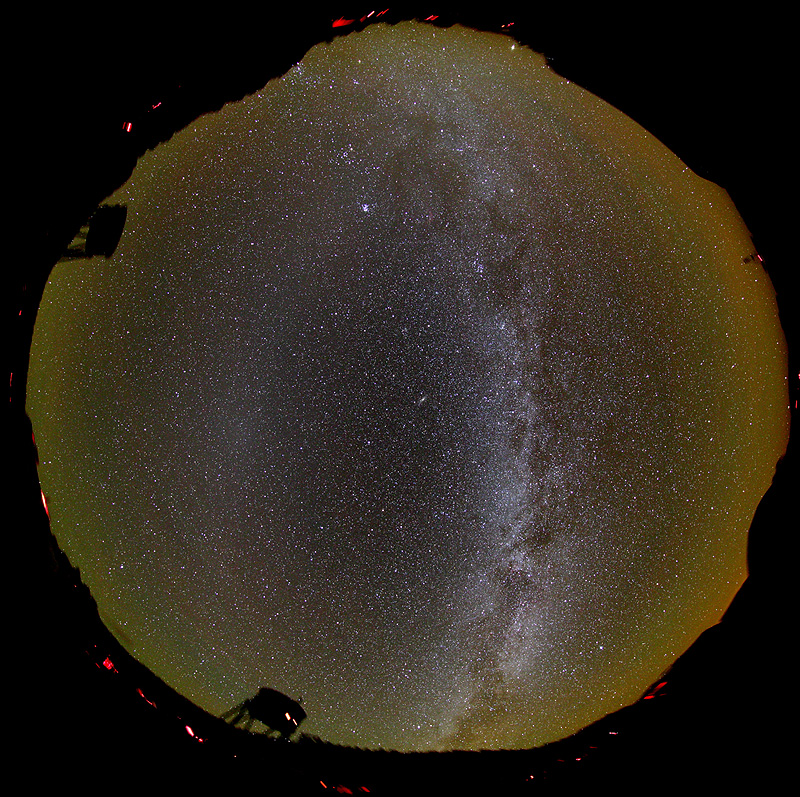 The image above was a longer exposure shows the gegenschein quite nicely. It is the noticeable brightening left of center. (By coincidence, the Andromeda Galaxy marks the center of this image.) The brightening also extends up and down from the gegenschein, curving back towards the center, almost mirroring the shape of the Milky Way, which itself arcs right of center from top to bottom. The two features connect at the top of the image in the winter Milky Way, but do not quite converge at the bottom of the image because much of the southern summer Milky Way has set. The faint arc is created by light reflecting off of dust within our solar system, viewed edge on since the Earth lies within it. The arc marks and illustrates the eccliptic, the plane of our solar system, because the dust orbits the sun just like the planets. The gegenschein lies at the antisolar point, opposite the sun in the sky, where reflection/scattering is the strongest from our earthly viewpoint, so the gegenschein is simply the brightest point in this illuminated dust band. This is the best image of the gegenschein/dust scattering that I have ever taken, and I love the symmetry with the much brighter Milky Way. As with previous images, skyglow is seen at the horizon, and telescopes and star party lights are seen there too. As for the telescopic observations at this star party, I had my best views ever of both Andromeda and M33 through the 32" f/3.6. Andromeda showed three dust lanes and seemed to extend forever, while M33 was huge and revealed knots and details that I had not seen before. M33 was also visible to the naked eye. That's about all I remember, other than many interesting planetaries, galaxies, and galaxy clusters seen through Joe's 32" on many long nights of observing. |
It was on the night of October 1-2 that a memorable event graced the Okie-Tex skies, one which seems to happen every few years, though this is the brightest I have seen. Early in the evening imagers noticed a bright red glow in the northern sky. We didn't really find out about this until after this night, and they thought it was probably a distant fire, which is not uncommon in this arid area. However, around midnight the glow increased in brightness, and vertical streaks appeared. This tipped us off that it was an aurora (Northern lights), and I raced to set up my camera. 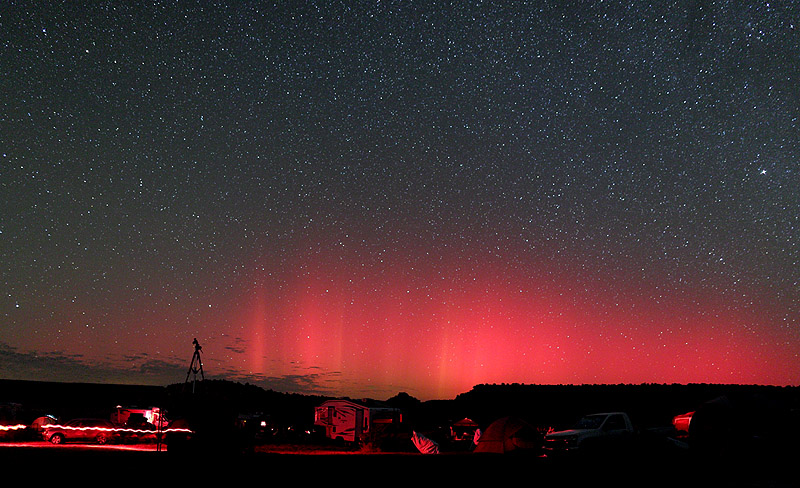 The above image shows some of the nice structure visible. The red color was not visible to my eye. This was a fairly rare display of the red color, since most aurora are green. 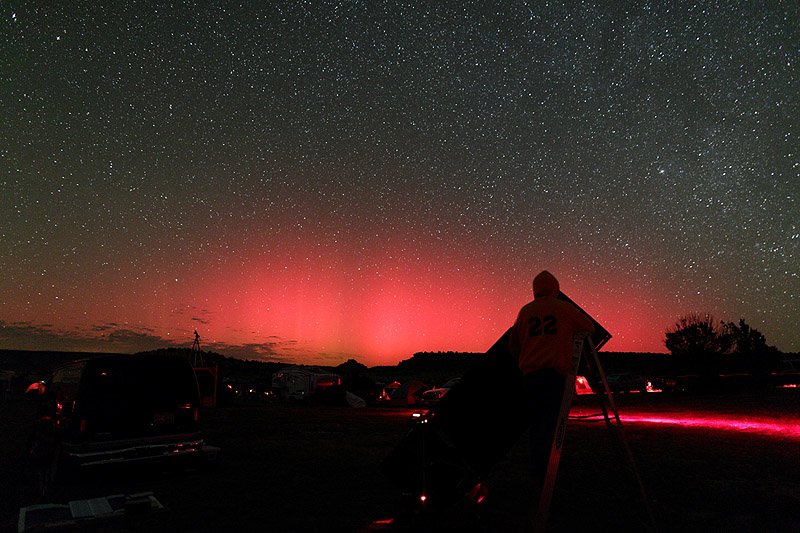 Above, John Pratte of JPAstrocraft observes through his 25" f/4 as the display goes on in the norther sky. 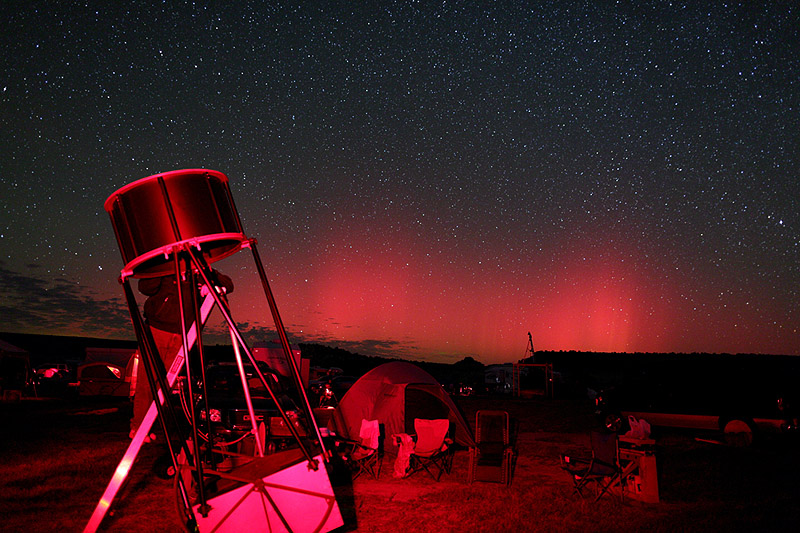 Of course the display changes by the second, so I kept shooting. Above someone views through Joe's 32" f/3.6 while the display continues. 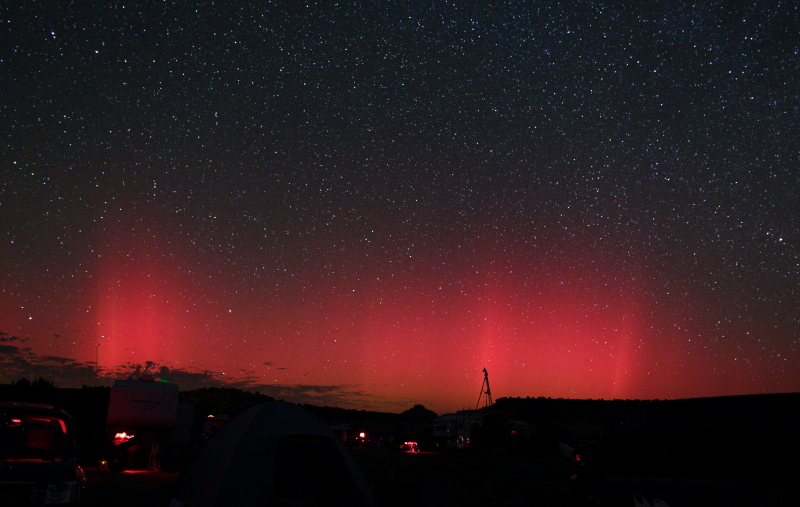 The bright rays subsided somewhat after about 10-15 minutes. 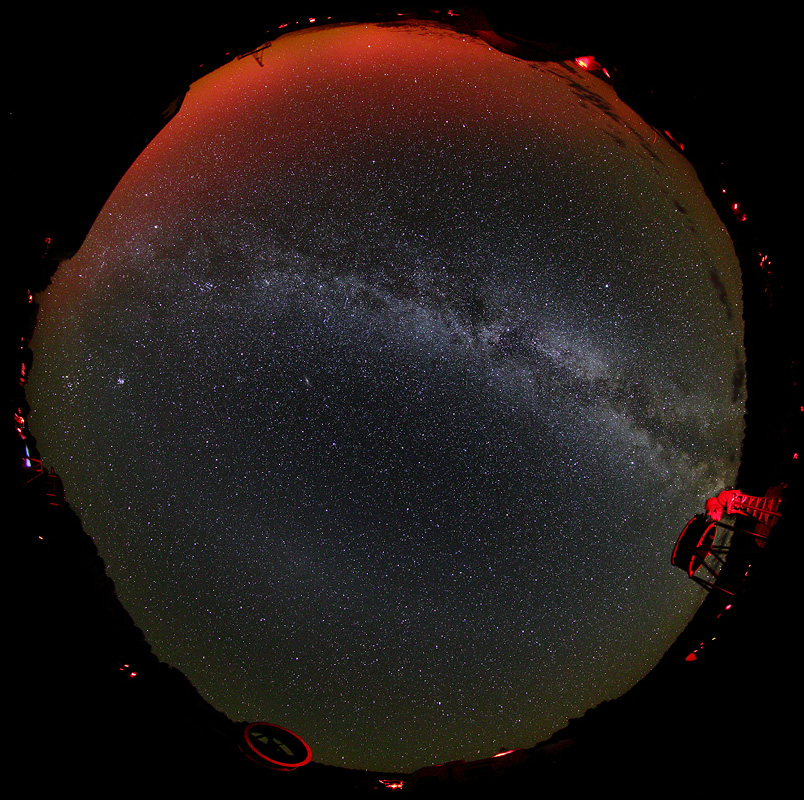 As the display died down, the red glow remained, so I set up for an all sky shot with about a four minute exposure. The result is seen above. In this one image, I captured telescopes and observers, green skyglow, a few clouds on the horizon, the gegenschein, and, of course, the northern lights. I have never seen that combination in one image before (nor the combination of gegenschein and aurora), so I submitted it for APOD, but it has not been featured there as of the writing of this article. I am quite proud of this image, as these things are rarely seen together. 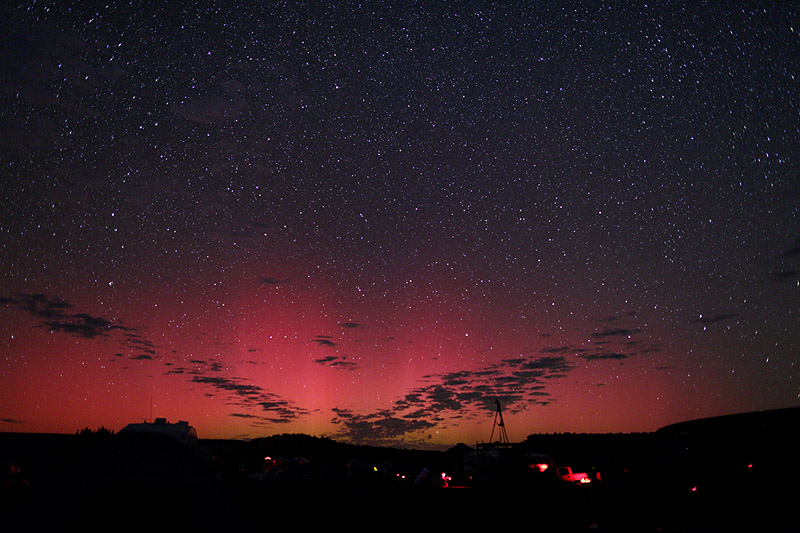 The display flared up again briefly around 3am, as a nice V-shaped bit of cloud was coming in to make the image a bit more interesting. 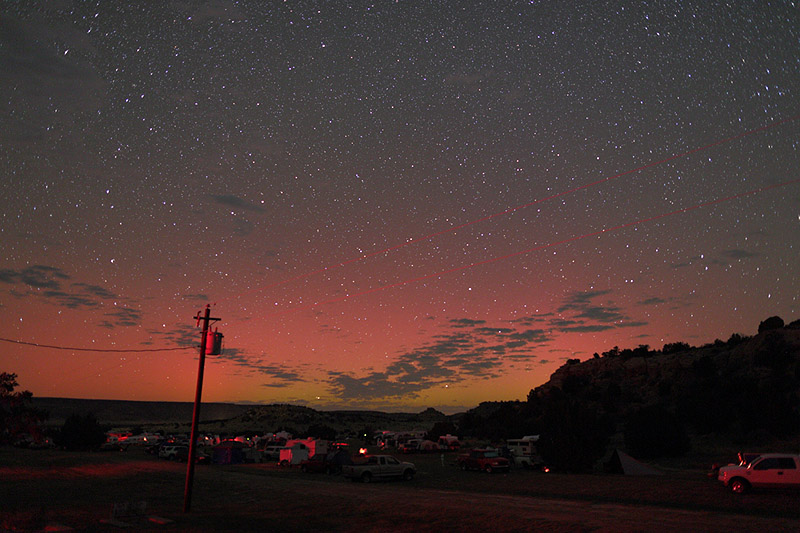 The last image above shows the display dying down around 3am, as seen over the eastern observing field from up near the bunkhouses. Some green skyglow is returning to the horizon, too. It was a good night. |
Mid-week I did my normal back-to-back two talks, "Adventures in big mirror making" and "Why aren't my stars round?". (My talks over the years are listed here, FYI). As the week continued, it was clear, clear, clear. At some point we were so tired that my eyes were beginning to play tricks on me at the eyepiece. I was seeing things moving, and I was not picking out faint details in objects with ease. Clearly some more sleep was needed, and I caught up a bit. On one day Joe and I headed to Clayton, NM to play some golf. We played their nice 9-hole course twice. It was windy, but the greens were very nice and rolled true. I recommend avoiding the rough, which contained some desert plants and catci. There were water hazards and bunkers, but I managed to avoid those. Some other golfers played in Boise City, so maybe we'll try that course out in 2014. I believe our drive home began on Friday, and late on that day I took the image below as we drove through Kansas. 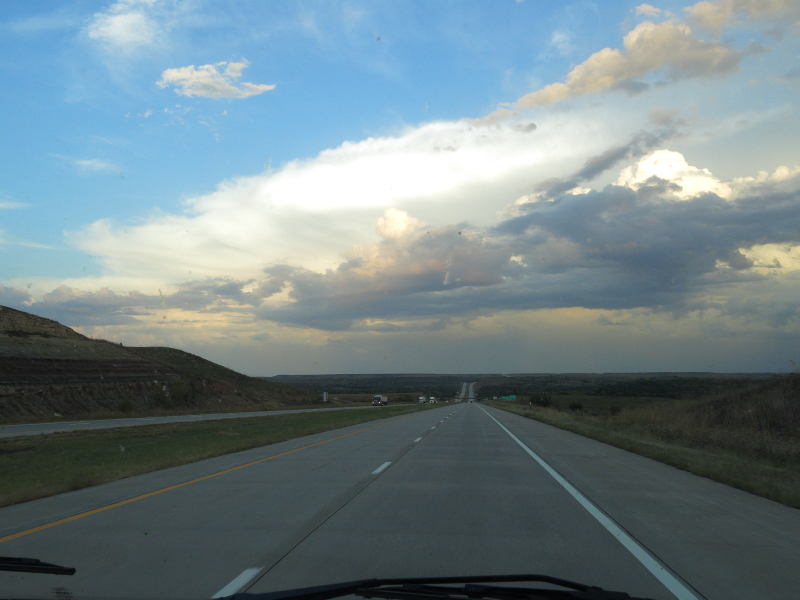 These dark clouds turned into significant storms and rain that we drove through Friday night and most of the way home on Saturday. It was quite a contrast to the warm, clear weather that we experienced at the western tip of the Oklahoma panhandle the previous week. Despite the fatigue, we can't wait to do it again September 20-28, 2014. If you're interested, here is the Okie-Tex Registration Site. Clear, dark skies, warm weather, good friends, good seeing, and cheers. -Mike Lockwood, Lockwood Custom Optics |